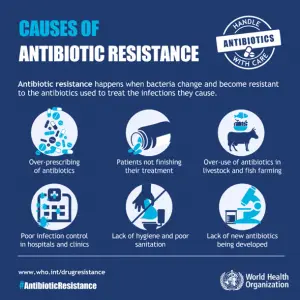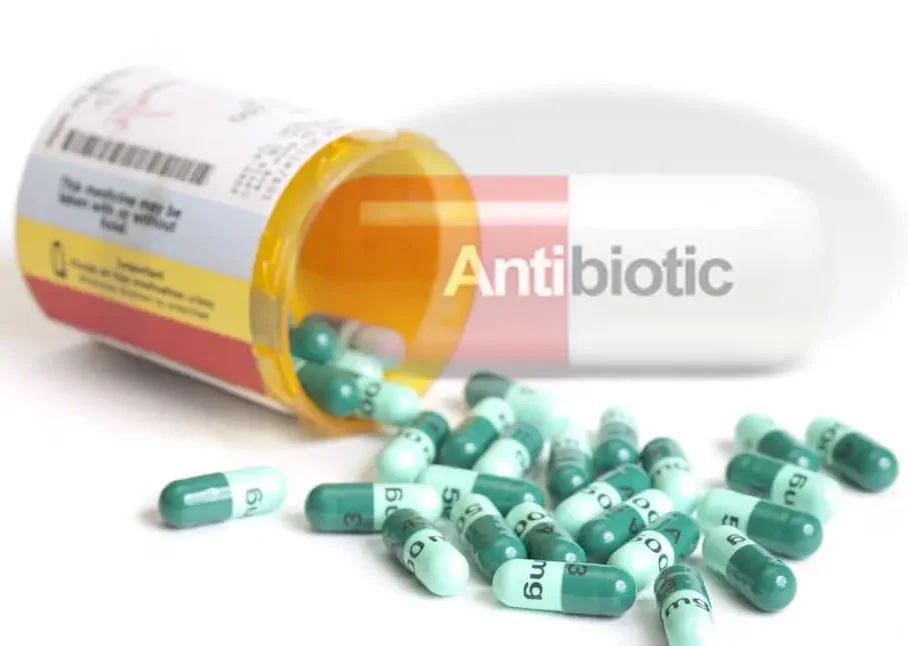When discovered in the 20th century, antibiotics were described as a turning point in human history by restricting the growth of and killing bacteria, thereby preventing an uncontrolled outbreak that could harm and kill many people. As a result of an increase in the spread of diseases, there has been a great surge in the prescription and consumption of antibiotics. However, the overuse of antibiotics can and has led to the evolution of resistant strains of bacteria.
What is antibiotic resistance and how does it happen?
Antibiotic-resistant bacteria are bacteria that cannot be controlled or killed by an antibiotic and continue to multiply in its presence. Some bacteria can even be resistant to multiple antibiotics, known as multi-resistant organisms. Diseases that were once considered to be easily curable from a course of antibiotics are now returning as mutated, resistant strains. These resistant strains undergo a genetic mutation that enables them able to withstand attacks by antibiotics, which results in them being able to replicate themselves rapidly and produce more colonies of resistant bacteria.
Resistance can also spread via horizontal gene transfer. This is where plasmids that carry the antibiotic resistance genes act as vectors and transfer this genetic material onto other bacteria. Although the mutation of the resistant strains is a natural phenomenon caused by the erroneous replication of a microorganism, the misuse of antibacterial drugs accelerates the process. This includes consuming antibiotics even when they are not the recommended course of treatment. For example, taking antibiotics to treat a viral infection promotes antibiotic resistance as the antibiotics attack beneficial or harmless bacteria. The antibiotic would be ineffective as viruses live and reproduce inside a host cell, unlike bacteria, which live on the surface of cells.

Potential consequences of antibiotic resistance
The more antibiotics are used; the more chances bacteria have to become resistant to them. Recently, as a result of the increase in antibiotic-resistant bacteria, more and more treatment options are becoming ineffective at inhibiting the growth of or killing the bacteria. Because of this, there are situations where patients are unable to be treated by available antibiotics, which hinders the treatment and could even lead to greater complications or death. More invasive treatments such as intravenous injections may have to be used, which have more severe side effects and are much more expensive than the ordinary antibiotic. The availability of effective antibacterial drugs is essential to progress in modern medicine. With the decrease in the efficacy of antibiotics against bacteria, the development of modern medicine is at risk as there are very few antibiotics that have been discovered and developed to replace those that are becoming ineffective. Common infections such as pneumonia that can spread in healthcare settings may not always respond to penicillin or any available antibiotics, putting the patients’ lives at risk. Antibacterial drugs that are used to prevent infection after surgery or to treat infection in intensive care may become less effective or completely ineffective.
Common antibiotic-resistant bacteria
- Methicillin-resistant Staphylococcus aureus (MRSA)
- carried on the skin and inside the nostrils and throat causing mild infections such as boils
- however, if the Staphylococcus aureus is able to break into the skin, it can cause extremely threatening infections such as blood poisoning
- resistant to a number of widely used antibiotics, meaning that it is much more difficult to treat than other bacterial infections
- spread through skin-to-skin contact with someone who has an MRSA infection or has the bacteria living under their skin
- Also spread through contact with contaminated objects like towels and clothes
- People are most at risk of becoming infected with MRSA if they are staying in hospitals as they are surrounded by a large number of people and so bacteria can spread much more easily. As well as this, there is often an entry point for bacteria to get into their body, such as a surgical wound or a urinary catheter
- They may have low immunity which would make them more vulnerable to infection
- Although MRSA is hard to treat, they are still treatable as the MRSA bacteria have not yet developed resistance to all antibiotics
- Vancomycin-resistant Enterococcus (VRE)
- Live in our intestines and on our skin
- If they become resistant to antibiotics, they can cause infection usually in the intestines, urinary tract, or wounds
- Spread from one person to another through contact or contaminated objects – not airborne
- If healthy, the chances of getting a VRE infection are very low
- Normally occur in people with weakened immune systems or people who have had major surgeries that had to be treated with multiple antibiotics
Transmission of antibiotic-resistant bacteria in hospitals and infection control
Bacteria can be passed in hospitals from person to person through:
- Contact with contaminated hands of hospital staff
- Contact with contaminated surfaces like door handles and call bells
- Contact with contaminated equipment like stethoscopes
Precautions are taken in all hospitals and healthcare facilities in order to provide a basic level of infection control for all patients to minimize the risk of transmission of infection from person to person, these include:
- The use of gloves, masks, and goggles to act as a barrier
- Good personal hygiene – hand washing before and after patient contact and the use of alcohol-based hand sanitizers
- Disposal of clinical waste appropriately
Additional precautions are taken if caring for a patient infected with highly infectious pathogens. High-risk pathogens are organisms that are resistant to standard sterilization procedures or caused by antibiotic-resistant bacteria. As well to this, organisms that can be spread through contact or droplets are at high risk. To control the spread of high-risk micro-organisms, the additional precautions put in place include:
- Specific patient-care equipment
- Single room with ensuite facilities or private toilet
- Restricted movement of patients and healthcare workers
Prevention of antibiotic-resistant bacteria
- When prescribed antibiotics, take the entire course without skipping doses and do not stop before finishing the full dose, even if you are feeling better
- Do not share or use leftover antibiotics, only take antibiotics that have been prescribed for you
- Discard any leftover medication once the prescribed course of treatment is completed
- Do not take antibiotics or ask for them if your doctor thinks you do not need them
- Prevent infections by getting the recommended vaccines and practicing good hand hygiene

